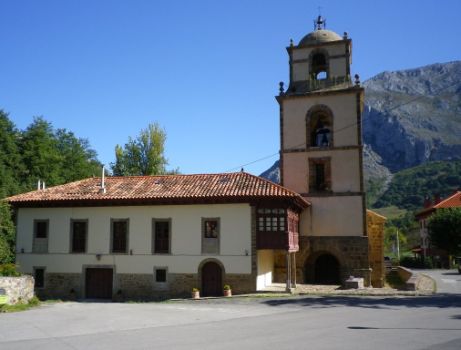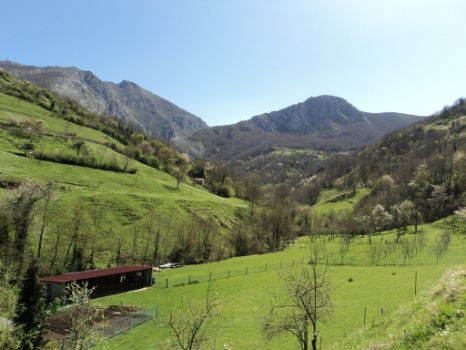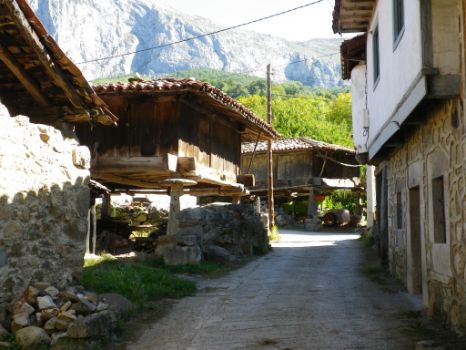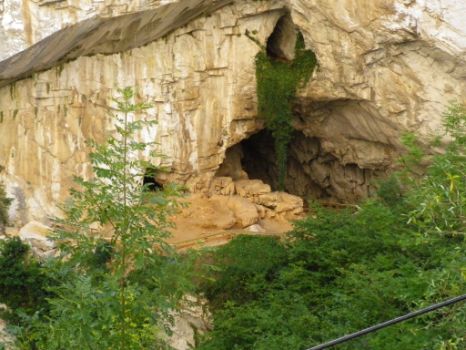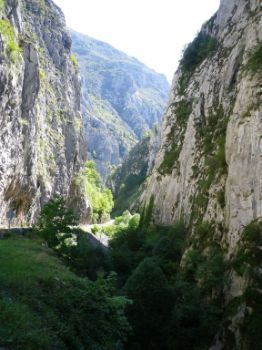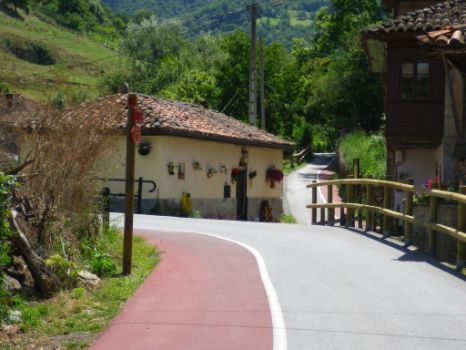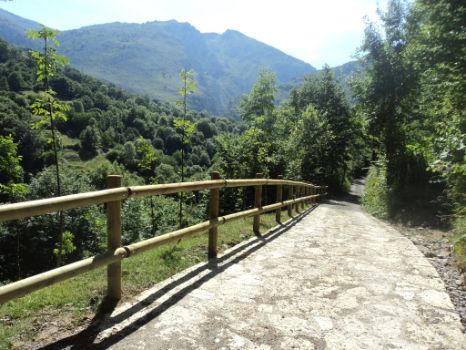Net of Natural
Trails

Senda del Oso Nature Trail. Entrago - Cueva Huerta Section
Description
In the footsteps of the brown bear along the mining railway line
The Nature Trail traverses the valley formed by the rivers Teverga and Páramo, in County Teverga, in the heart of the Cantabrian Mountains. The route runs along the old railway line on which small steam locomotives transported iron and coal between the mining valleys of Quirós and Teverga. The mining crisis led to the shutdown of the railway line in 1963. People now walk along the tracks on which the trains used to run.
This route runs along part of one of the most iconic trails in the Cantabrian Mountains: the Camín Real, an ancient pre-Roman road that was part of the Roman “Ruta de la Plata”. Furthermore, this route is an extension of the popular Bear Trail that starts in the Principality of Asturias.
Nearly nine kilometres in length, the Trails begins in Entrago (Entragu), passing through the towns of Samartín, Las Veigas, Riellu, San Salvador, and near Fresneu, and ends in the impressive cave of Cueva Huerta. The route, a combination of historical remains and natural elements, allows the traveller to enjoy the immense contrasts in altitude found in Las Ubiñas-La Mesa Nature Park.
The Nature Trail, which begins in the town of Entragu, has information panels and directional signs throughout. Nestled in the foothills of the impressive Sierra de la Sobía, Entragu has no shortage of ancestral manors. Prominent amongst these is the 17th century Palacio de los Condes de Agüera, closely linked to the lineage of Miranda, a legacy of a bygone age in which lords and marquises dominated the county organised as independent valleys.
The path continues to Samartín-La Plaza, the most important town in County Teverga. At the edge of town is the now abandoned Palacio de los Marqueses de Valdecarzana, built in the late sixteenth century, which housed several generations of a branch of the Miranda family.
Past the square is the church of San Pedro, from the late tenth or early eleventh century, an example of the transition from pre-Romanesque to Romanesque style. Worthy of note are the ashlar walls and engraved figures of animals that populated the valley in the Middle Ages.
From Las Veigas, the route runs through a wilder natural environment, in the heart of the Nature Park, where wildlife abounds in the valley and Sierra de la Sobía. The route heads towards Riellu, a beautiful and quiet village nestled alongside the River Páramo. The parish church of Santo Tomás, a former Romanesque abbey altered several times, as well as its 17th century façade, are worth a visit.
The clear water of the River Páramo flows over the stones of the riverbed teeming with life. Further on, the route begins a steep climb through a beautiful chestnut forest (Castanea sativa), the Castañedón as it is known, where moss and fern grow under centenary trees.
Forested area accounts for nearly one third of the extension of the Las Ubiñas-La Mesa Nature Park, where chestnut trees dominate the lowlands. During the descent, the route passes through the green meadows of Valdelaurina, at the foot of the impressive walls of Sierra de la Sobía.
The Nature Trail traverses the town of San Salvador, crossing the River Páramo near the houses. The ruins of the Castle of Alesga can be seen from here, with its medieval watchtower overlooking the valley. San Salvador has an interesting ensemble of folk architecture. The perfectly preserved and restored houses reflect the harmony of Asturian rural buildings.
Leaving San Salvador behind, the route comes across a fountain along the path where one can refresh. The steeper part of the Nature Trail begins here. The route ventures into the forest, through a quiet path that crosses a footbridge over one of many brooks in the valley.
The town of Fresneu is visible from the road on the opposite side of the valley, very near the end of the route. Making a slight detour from the Nature Trail, one can visit the Parque de la Prehistoria, a museum of Upper Palaeolithic art in Europe, with exact replicas of the caves of Altamira and Tito Bustillo, amongst others.
Intriguing prehistoric cave paintings dating back over 3,000 years, created by cave dwellers in the Fresneu mountain range in the late Bronze Age, can be found near the Parque de la Prehistoria. Here, in the most inaccessible peaks, with a little luck and patience, the king of the valley, the brown bear (Ursus arctos) may be seen.
The presence of bears is an everyday occurrence in the valley. The area is also a major ecological corridor that connects with the meagre bear population living in the eastern Cantabrian Mountains. Past the place known as Presorias, through meadows and woodlands populated with oaks (Quercus robur), beeches (Fagus sylvatica) and birches (Betula sp.), the route finally arrives at the gorge where Cueva Huerta is located.
Cueva Huerta Natural Monument, a huge cave, should only be visited accompanied by an expert guide. After visiting one of the most beautiful corners of Asturias, the Nature Trail comes to an end.
Sites of interest
Puntos de interés
Culture
- Colegiata de San Pedro
- Castillo de Alesga
- Abrigos rupestres de Fresnedo
- Palacio de Valdecarzana
- Iglesia de Nuestra Señora de Cébrano
- Parque de la Prehistoria
- Palacio de los condes de Agüera (Entrago)
Municipality
Orography
Vegetation
Profile

(Calculated according to the MIDE criteria for an average excursionist with a light load)
Highlights
Further information
Cueva Huerta
This impressive cave of hydrogeological and biological interest in Fresnedo (Teverga) was declared a Natural Monument in 2002. The bat colony in the cave has been designated of Special Interest and Community Interest.
It is currently the second most important cave system in Asturias with a total 14.5 km of galleries. It forms part of a unique karst system, consisting of a gorge, sink, large cave, various underground watercourses and resurgence.
Cueva Huerta jealously guards various natural treasures, including the Sala de «Gours», small holes in the ground created by water droplets, situated about 25 m from the entrance. Less than 40 m further on, there is another unique phenomenon, the Sima del Caracol, and 29 m further on is the Paso del Perro, a drop of just over 2 m in height. The visit to the Galería Vieja includes the Catedrales, interesting, Gothic-like rock formations; the Santina, a geological formation that resembles a natural altar; and El Sillón de la Reina.



